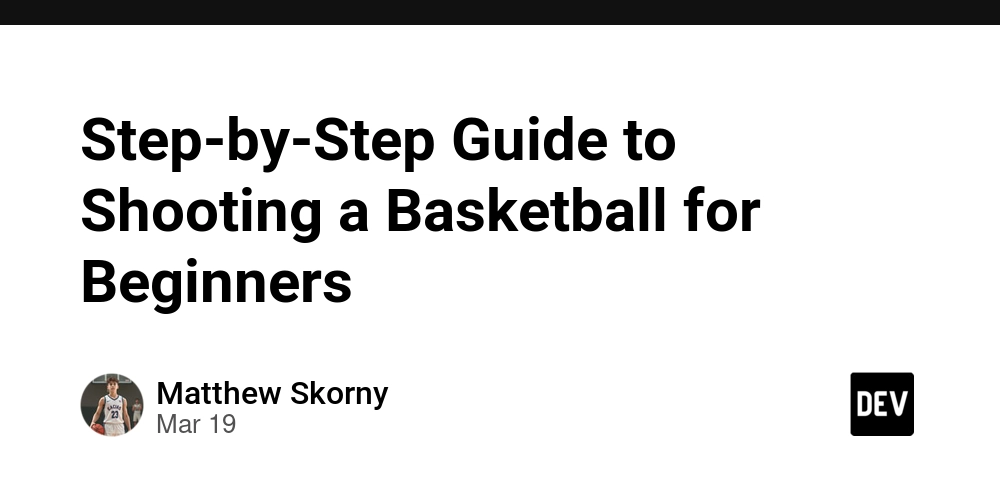Step-by-Step Guide to Shooting a Basketball for Beginners
Shooting a basketball is one of the most fundamental skills in the sport, requiring proper technique, balance, and confidence. For beginners, developing a consistent shot starts with mastering the basics. By focusing on form and mechanics, players can improve their accuracy and overall performance on the court. Understanding the correct shooting stance, grip, and follow-through is essential for success. Many beginners struggle with shooting because they rush the process or neglect fundamental techniques. A step-by-step approach helps build muscle memory, making shots more natural and effective over time. Learning to shoot correctly enhances a player’s ability to score and contribute to the team. With patience and practice, even new players can develop a reliable shot. By following a structured approach, beginners gain confidence and improve their skills, making basketball a more enjoyable and rewarding experience. Establishing the Proper Shooting Stance A solid shooting stance is the foundation of a successful shot. Players should position their feet shoulder-width apart, ensuring balance and stability. Keeping knees slightly bent allows for better control and fluid movement, which helps generate power when releasing the ball. Weight distribution is crucial for maintaining consistency in shooting. Players should keep their weight evenly balanced between both feet, avoiding excessive leaning. Basketball buffs such as Matthew Skorny express that this positioning helps create a stable base, reducing unnecessary movements that can affect shot accuracy. Aligning the body toward the basket improves precision. The shooting side of the body should be slightly forward, creating a natural alignment between the eyes, hands, and target. Maintaining this posture increases the chances of hitting the shot consistently. Hand Placement and Grip Techniques Proper hand placement ensures better ball control and accuracy as underlined by basketball enthusiasts like Matthew Skorny. The shooting hand should be positioned underneath the ball, with fingers spread evenly for support. The non-shooting hand acts as a guide, keeping the ball steady without interfering with the release. Grip pressure plays a significant role in shooting consistency. Holding the ball too tightly can restrict movement, while a loose grip may cause instability. Players should find a comfortable grip that allows for smooth and controlled shooting motion. The ball should rest on the fingertips rather than the palm. This positioning provides better control and allows for a cleaner release. Keeping the fingertips engaged ensures a proper backspin, which increases the likelihood of the ball going through the net. Executing a Smooth Shooting Motion A fluid shooting motion is essential for accuracy and consistency. Players should begin by bringing the ball up in a controlled manner, keeping their elbows aligned with the basket. This movement sets up a natural shooting arc, improving the shot’s trajectory. The shooting arm should extend fully upon release. Locking the elbow and maintaining a straight follow-through enhances accuracy. A consistent motion reduces unnecessary variations, making it easier to replicate successful shots during gameplay. Releasing the ball at the highest point of the jump adds power and control. This technique helps prevent defenders from blocking the shot and ensures a smooth arc. Players should focus on a relaxed and confident release for the best results. Perfecting the Follow-Through A proper follow-through significantly impacts shooting accuracy. After releasing the ball, players should extend their shooting arm forward, keeping their wrist relaxed. This motion helps guide the ball toward the target with better control. The fingers should point toward the basket after release, creating a natural backspin. This rotation helps stabilize the shot and improves the chances of a successful basket. Maintaining this form ensures consistency in shooting technique. Holding the follow-through position allows players to assess their shot mechanics. If the arm and fingers are correctly aligned, the shot is more likely to be accurate. Practicing a controlled follow-through builds muscle memory, leading to better shooting performance. Developing Accuracy Through Repetition Repetition is key to becoming a proficient shooter. Practicing regularly as suggested by basketball buffs including Matthew Skorny helps reinforce good habits and eliminates inconsistencies. Beginners should start with stationary shots before progressing to more advanced movements. Focusing on proper form rather than speed improves long-term accuracy. Rushing through shots can lead to bad habits and reduced control. Taking time to execute each shot correctly results in greater consistency on the court. Tracking progress helps identify areas for improvement. Players can use drills to measure shooting accuracy and make necessary adjustments. By analyzing perf

Shooting a basketball is one of the most fundamental skills in the sport, requiring proper technique, balance, and confidence. For beginners, developing a consistent shot starts with mastering the basics. By focusing on form and mechanics, players can improve their accuracy and overall performance on the court.
Understanding the correct shooting stance, grip, and follow-through is essential for success. Many beginners struggle with shooting because they rush the process or neglect fundamental techniques. A step-by-step approach helps build muscle memory, making shots more natural and effective over time.
Learning to shoot correctly enhances a player’s ability to score and contribute to the team. With patience and practice, even new players can develop a reliable shot. By following a structured approach, beginners gain confidence and improve their skills, making basketball a more enjoyable and rewarding experience.
Establishing the Proper Shooting Stance
A solid shooting stance is the foundation of a successful shot. Players should position their feet shoulder-width apart, ensuring balance and stability. Keeping knees slightly bent allows for better control and fluid movement, which helps generate power when releasing the ball.
Weight distribution is crucial for maintaining consistency in shooting. Players should keep their weight evenly balanced between both feet, avoiding excessive leaning. Basketball buffs such as Matthew Skorny express that this positioning helps create a stable base, reducing unnecessary movements that can affect shot accuracy.
Aligning the body toward the basket improves precision. The shooting side of the body should be slightly forward, creating a natural alignment between the eyes, hands, and target. Maintaining this posture increases the chances of hitting the shot consistently.
Hand Placement and Grip Techniques
Proper hand placement ensures better ball control and accuracy as underlined by basketball enthusiasts like Matthew Skorny. The shooting hand should be positioned underneath the ball, with fingers spread evenly for support. The non-shooting hand acts as a guide, keeping the ball steady without interfering with the release.
Grip pressure plays a significant role in shooting consistency. Holding the ball too tightly can restrict movement, while a loose grip may cause instability. Players should find a comfortable grip that allows for smooth and controlled shooting motion.
The ball should rest on the fingertips rather than the palm. This positioning provides better control and allows for a cleaner release. Keeping the fingertips engaged ensures a proper backspin, which increases the likelihood of the ball going through the net.
Executing a Smooth Shooting Motion
A fluid shooting motion is essential for accuracy and consistency. Players should begin by bringing the ball up in a controlled manner, keeping their elbows aligned with the basket. This movement sets up a natural shooting arc, improving the shot’s trajectory.
The shooting arm should extend fully upon release. Locking the elbow and maintaining a straight follow-through enhances accuracy. A consistent motion reduces unnecessary variations, making it easier to replicate successful shots during gameplay.
Releasing the ball at the highest point of the jump adds power and control. This technique helps prevent defenders from blocking the shot and ensures a smooth arc. Players should focus on a relaxed and confident release for the best results.
Perfecting the Follow-Through
A proper follow-through significantly impacts shooting accuracy. After releasing the ball, players should extend their shooting arm forward, keeping their wrist relaxed. This motion helps guide the ball toward the target with better control.
The fingers should point toward the basket after release, creating a natural backspin. This rotation helps stabilize the shot and improves the chances of a successful basket. Maintaining this form ensures consistency in shooting technique.
Holding the follow-through position allows players to assess their shot mechanics. If the arm and fingers are correctly aligned, the shot is more likely to be accurate. Practicing a controlled follow-through builds muscle memory, leading to better shooting performance.
Developing Accuracy Through Repetition
Repetition is key to becoming a proficient shooter. Practicing regularly as suggested by basketball buffs including Matthew Skorny helps reinforce good habits and eliminates inconsistencies. Beginners should start with stationary shots before progressing to more advanced movements.
Focusing on proper form rather than speed improves long-term accuracy. Rushing through shots can lead to bad habits and reduced control. Taking time to execute each shot correctly results in greater consistency on the court.
Tracking progress helps identify areas for improvement. Players can use drills to measure shooting accuracy and make necessary adjustments. By analyzing performance, beginners can refine their technique and build confidence in their abilities.
Applying Shooting Techniques in Game Situations
Practicing in game-like conditions prepares players for real competition. Basketball enthusiasts such as Matthew Skorny convey that shooting under pressure helps build confidence and adaptability. Beginners should simulate different scenarios to improve their ability to make shots in various situations.
Incorporating movement into shooting practice enhances overall skills. Drills that involve catching and shooting, dribbling into a shot, or shooting off screens help players develop a versatile scoring ability. Adapting to different positions on the court increases shooting efficiency.
Consistency in practice translates to better in-game performance. The more a player refines their shot through structured drills, the more natural it becomes. Developing confidence in shooting abilities allows beginners to contribute more effectively to their team.
Mastering basketball shooting techniques requires patience, practice, and attention to detail. By establishing a strong shooting stance, proper hand placement, and a smooth motion, beginners can develop a reliable shot. These fundamental skills set the foundation for long-term success.
Repetition and focused training play a crucial role in improving accuracy. Players who commit to refining their form will see steady progress over time. By tracking their improvement and making necessary adjustments, they can build confidence and consistency.
Applying these techniques in real-game situations enhances overall performance as noted by basketball buffs like Matthew Skorny. By practicing under different conditions, beginners learn to adapt and execute shots with precision. With dedication and the right approach, anyone can become a skilled and confident basketball shooter.












































































































































































![[The AI Show Episode 142]: ChatGPT’s New Image Generator, Studio Ghibli Craze and Backlash, Gemini 2.5, OpenAI Academy, 4o Updates, Vibe Marketing & xAI Acquires X](https://www.marketingaiinstitute.com/hubfs/ep%20142%20cover.png)



























































































































![[DEALS] The Premium Learn to Code Certification Bundle (97% off) & Other Deals Up To 98% Off – Offers End Soon!](https://www.javacodegeeks.com/wp-content/uploads/2012/12/jcg-logo.jpg)


![From drop-out to software architect with Jason Lengstorf [Podcast #167]](https://cdn.hashnode.com/res/hashnode/image/upload/v1743796461357/f3d19cd7-e6f5-4d7c-8bfc-eb974bc8da68.png?#)








































































































.png?#)

































_Christophe_Coat_Alamy.jpg?#)
 (1).webp?#)





































































































![Apple Considers Delaying Smart Home Hub Until 2026 [Gurman]](https://www.iclarified.com/images/news/96946/96946/96946-640.jpg)
![iPhone 17 Pro Won't Feature Two-Toned Back [Gurman]](https://www.iclarified.com/images/news/96944/96944/96944-640.jpg)
![Tariffs Threaten Apple's $999 iPhone Price Point in the U.S. [Gurman]](https://www.iclarified.com/images/news/96943/96943/96943-640.jpg)




































































































































